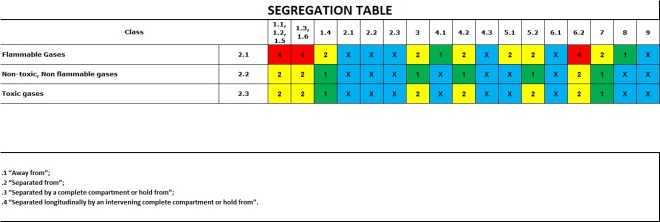A particular Gas may be incompatible with the cylinder or any packaging in which it is stored or with the pipelines through which it passes. For example Acetylene will react with zinc and copper, hydrogen sulphide will react with brass..

There was an incident in which an aluminium cylinder containing ethyl chloride and helium with trace amounts of 1,1,1-trichloroethane and trichloroethylene exploded in a cargo warehouse in the Dubai Airport. This was due to non-compatibility of the mixture of gases and the material of cylinder.
Two different gases may react with each other, example Acetylene, which is a highly flammable gas will dangerously react with Chlorine which is a strong oxidizing agent; water-reactive gas.
In transport regulations gases are classified as below
Class 2: Gases
Class 2.1: flammable gases
Class 2.2: non-flammable, non-toxic gases
Class 2.3: toxic gases
According to physical state transport condition of gases are divided in to four;
- Compressed gas
- Liquefied gas
- Refrigerated liquefied gas
- Dissolved gas.
While storing gas in cylinders or any pressure receptacles or while transporting or storing different gases together, one must take into consideration of below;
- Compatibility of gas with the storage device (materials of the cylinder made of).
- Compatibility of gases stored or transported together (chemical reactions between the gases in case of leakage of both or when involved together in fire what may be the consequences).
- Compatibility of gas with other goods
- Any other safety concerns
Below is the segregation table for gases as per IMDG Code, in this we can see the different clauses for transporting gas by ocean going vessels.

For sea transport one must look in to the individual provisions in IMDG Code for each gas before deciding whether it can be stored together on a ship.







